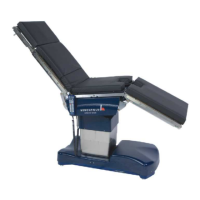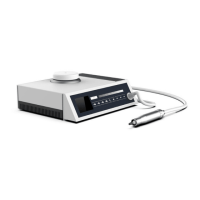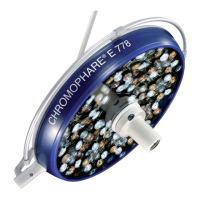Do you have a question about the Berchtold Operon D860 and is the answer not in the manual?
Explains the purpose and scope of the operator manual and notes on illustrations.
Details warning symbols (DANGER, WARNING, CAUTION) and other marks used in the manual.
States the manufacturer's disclaimer for damages resulting from improper use or non-compliance.
Confidentiality notice and copyright information for the manual's content.
Information on how to review and download warranty provisions and general terms.
Provides contact information for technical questions and support.
Lists the safety standards and UL file number the device is listed to.
Provides a labeled diagram of the OPERON Surgical Mobile Operating Table.
Summarizes the table's battery-driven nature, adjustment options, and features.
Notes that functional descriptions of controls are in the 'Operation' chapter.
Highlights potential pinch points, noting the list is not exhaustive.
Lists the items included in the OPERON MOT OR Table package.
Warns about accessories affecting motion limits and advises on proper usage.
Lists requirements for the installation site, including space, levelness, and accessibility.
Provides instructions for unpacking and installing the OR table, including tools needed.
Explains how to attach pads, emphasizing the use of correct antistatic pads.
Details how to connect the hand pendant to the control sleeve.
Describes how to connect the optional foot control to the control sleeve.
Provides safety instructions and steps for connecting the power supply.
Explains the procedure for connecting the potential equalization cable.
Lists essential checks to perform before the first use of the OR table.
Highlights risks of crushing, pinching, and material damage during operation.
Warns about risks of injury from incorrect patient positioning and load limits.
Details collision detection and software limits for various table functions.
Explains how to operate the hand pendant and lists adjustable functions.
Describes how to read the battery charge indicator and prerequisites for checking.
Provides instructions for locking and unlocking the OR table using the FLOOR LOCK button.
Explains how to set reverse orientation and associated safety warnings.
Details safe procedures for moving the OR table, including patient security.
Outlines conditions and safety precautions for repositioning the table with a patient.
Describes manual methods for moving the table when it's not occupied.
Explains how to use the InstaDrive™ feature for moving the table.
Details the installation of the optional arc docking system for the hand pendant.
Illustrates how to adjust the table sections and height using buttons.
Covers adjusting patient position and emphasizes monitoring table movement.
Explains the LEVEL function to return the table to its zero point position.
Describes how to use preset positions like FLEX and CHAIR.
Explains the operation of the optional foot control and its rocker switch.
Details how to adjust the headrest, including dual articulating models.
Provides instructions on how to remove and exchange table sections safely.
Covers cleaning procedures for the OR table and its components.
Explains when and how to charge the table's batteries.
Provides instructions for cleaning, disinfecting, and maintaining the hand pendant.
Presents dimensional drawings and specifications for table components.
Discusses patient positioning, normal vs. reverse orientation, and load capacities.
Specifies maximum load capacities for normal and reverse orientations.
Illustrates various motion ranges like Trendelenburg, tilt, and leg section adjustments.
Provides general specifications like weight, length, width, and height range.
Details electrical connection specifications including voltage, current, and fuse protection.
Refers to the appendix for information on electromagnetic compatibility (EMC).
Specifies the safety class, application part type, and operating mode.
Summarizes maximum load capacities for different orientations and lift functions.
Lists environmental specifications like temperature range and humidity.
Provides information on hydraulic fluid and how to obtain data.
Describes the information found on the product label, such as serial number and model.
Defines the exclusive use of the OR table for patient positioning in medical rooms.
Describes residual risks and the importance of following safety instructions.
Highlights risks like infection due to hygiene and dangers if the unit is used incorrectly.
Warns about risks of crushing or pinching from moving parts and pinch points.
Mentions that nicks and scratches on surfaces can be visible on X-ray.
Outlines the owner's legal obligations for safe operation, maintenance, and training.
Details the qualifications and training needed for various tasks.
Specifies qualifications for BERCHTOLD technicians, engineers, and medical specialists.
Warns about risks to unauthorized persons in danger and work zones.
Mandates providing regular instruction to operators and maintaining an instruction protocol.
Lists required PPE, including protective clothing, gloves, and safety shoes.
Addresses safe handling and disposal of hazardous substances like hydraulic fluid and batteries.
Emphasizes maintaining legible safety, warning, and instruction signs.
Describes warning labels on the device, including tipping safeguards and no-storage warnings.
Stresses using only original or approved spare parts to avoid injury and warranty voiding.
Details procedures to prevent accidental power-up during maintenance.
Provides guidelines for safe unloading and internal transfer of the OR table.
Instructs on checking deliveries for completeness and damage.
Explains common shipping symbols like 'Up', 'Protect from wetness', and 'Fragile'.
Details conditions for transporting items attached to pallets using a forklift.
Outlines recommended storage conditions, including temperature, humidity, and protection.
Warns about risks of injury from improperly performed maintenance tasks.
Describes regular inspection and maintenance tasks for optimal device performance.
Lists steps to take after maintenance, including checking connections and cleaning the area.
Explains how malfunctions are reported via indicator lights on the pendant and main switch.
Lists common problems, their causes, and recommended remedies.
Provides guidance on troubleshooting issues related to the foot pump and other functions.
Explains how to use the auxiliary hand pendant for table movement in emergencies.
Details the operation of the Auxiliary hand pendant D 850 with the foot pump.
Describes the operation of the Auxiliary hand pendant D 820/D 760 with the foot pump.
Warns of injury risks during disassembly due to sharp parts and load.
Outlines steps for safe disassembly, including power disconnection and material removal.
Guides on environmentally responsible disposal of parts, batteries, and packaging.
Explains EMC precautions for electrical medical devices and intended environments.
Lists emissions measurement standards and compliance guidelines for electromagnetic fields.
Details immunity checks against electrostatic discharge, surges, and voltage fluctuations.
| Brand | Berchtold |
|---|---|
| Model | Operon D860 |
| Category | Medical Equipment |
| Language | English |


